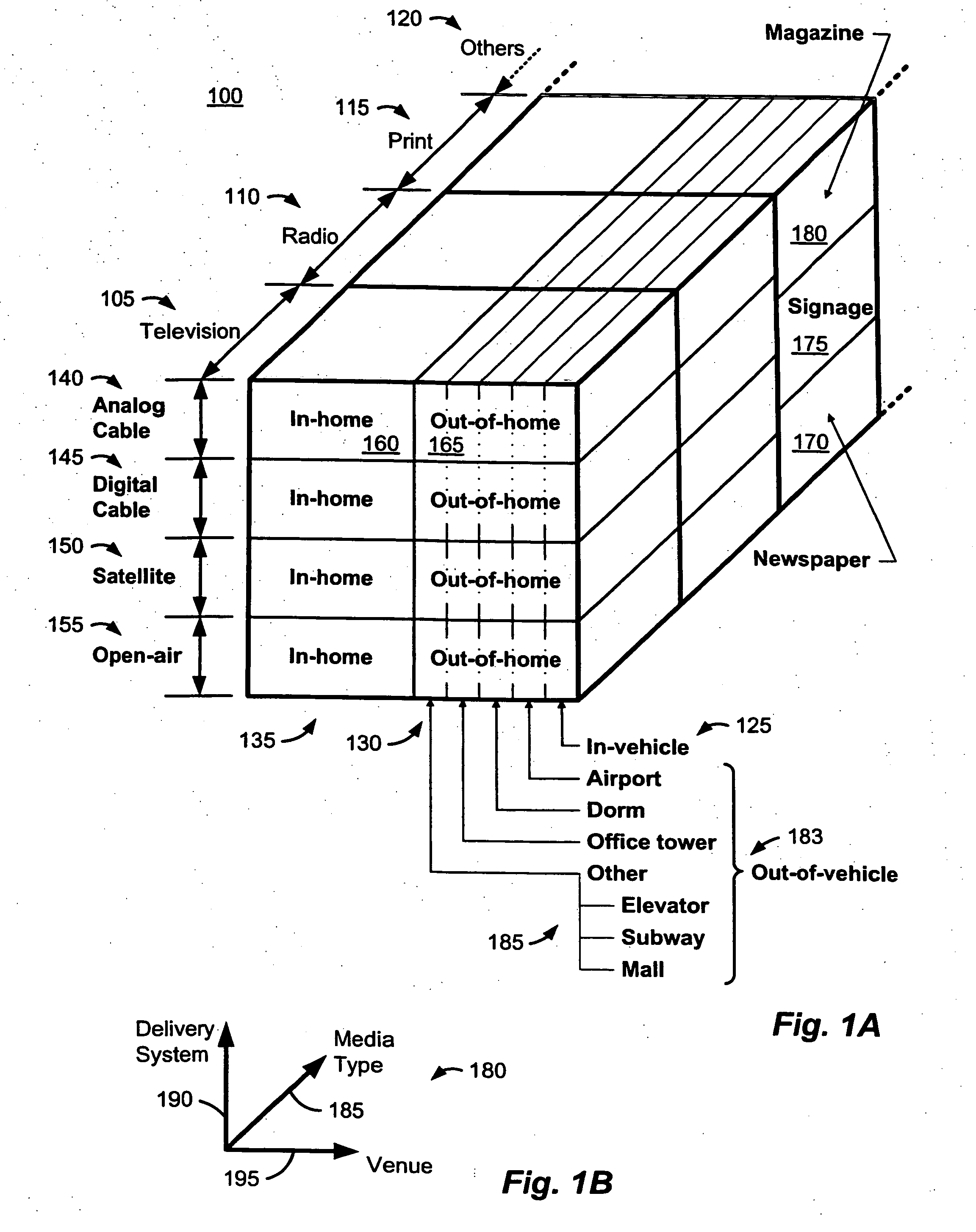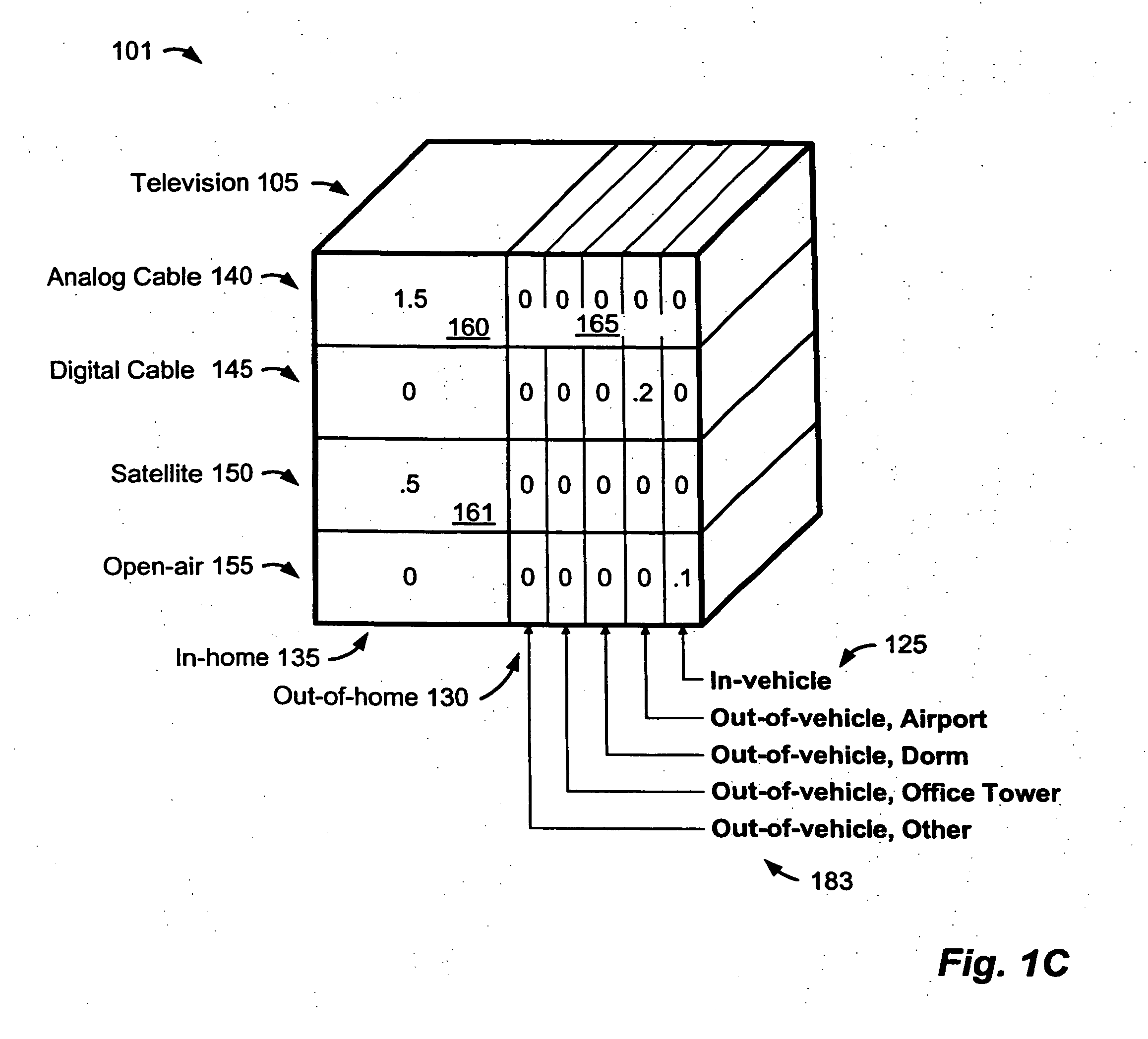As a result, the advertisers have more difficulty reaching
mass numbers of the consumers.
In addition, the promoters have more difficulty guaranteeing that many of the consumers will watch, hear, read, or otherwise absorb or become exposed to the entertainment content and the advertisements.
This phenomenon has led to lower advertising fees and lower profits for the promoters.
However, the consumers typically ignore or avoid the advertisements.
As a result, the effectiveness of
mass media advertising has been questioned.
This array of alternatives causes complexities in conventional methods for estimating audiences.
The access controls of such private networks can limit accurately estimating and characterizing an audience for a specific content segment.
One drawback of conventional forms of set-top-box-based audience monitoring is that audience characterization is typically constrained to
signal-based forms of media that flow through the
set top box.
Consequently, such conventional monitoring often fails to provide a comprehensive view of the wide spectrum of media forms that most audiences encounter.
Further, exclusively using set top boxes to characterize an audience's exposure to media does not generally provide a detailed profile of media exposure that segments exposure according to
media type, media
delivery system, and exposure venue.
For example, the advertising agency may not have access to a comprehensive profile of the consulting firm's prospective clients, including the various forms of media exposures that those prospects experience on a routine basis.
Further, the agency may not have a clear picture of the
demographics of the individuals that frequent the corridor or an accurate profile of the various forms of media that those individuals regularly encounter.
While the advertising agency may have access to certain types of media exposure information from commercial sources, such as ratings bureaus, such conventional exposure information is often fragmented, incomplete, or limited in scope.
However, such conventional profiles often fail to provide comprehensive information about the audience and its exposure to media, such as an accounting of the media forms which the audience encounters.
Accordingly, advertisers and their advisors often make advertising decisions based on imperfect or incomplete information.
Another problem with conventional media exposure technology is a lack of flexibility or adaptability.
An advertiser or other party interested in using media for a business purpose often cannot obtain adequate information from conventional media profiles to support an informed decision regarding media selections.
And, those tools are often misapplied or applied in a one-size-fits-all approach that yields blurred or inaccurate results.
That is, conventional technology for obtaining media exposure information generally lacks a capability to select specific or “best-of-
breed” monitoring tools for each of
multiple exposure situations.
For example, conventional ratings approaches often entail attempting to cover too many markets and too many media technologies with a single, ill-suited monitoring technology.
Failing to select the proper monitoring technology can result in
exposure data that does not properly account for the details, distinctive features, or peculiarities presented by various combinations of media types, media venues, and media delivery systems.
Further, conventional media profiles are often produced by monitoring a narrow media segment and then wrongly assuming that the information collected from the monitored segment applies to another, distinct media segment or a broader segment.
The underlying assumption can be erroneous.
Further, the resulting media profile may provide an estimate about many sectors while not covering any sector with a sufficient
level of detail or accuracy.
The limited number of vendors of
exposure data sources may compel the party to use exposure data from a single vendor, such as Nielsen Media Research of New York, N.Y., even though that vendor's data may not adequately suit the party's needs.
That is, the limited number of commercial sources for exposure data may undesirably constrain an advertiser's choices of exposure profiles.
As a result, the advertiser may base an advertising decision on information that lacks adequate specificity to support making the best decision.
With limited sources of ratings information and inadequate competition, conventional ratings may lack a suitable level of
granularity.
Moreover, conventional technologies and approaches often fall short in terms of adequately detailing exposure in narrow categories of venues and in terms of associating delivery technologies with exposures.
For example, conventional ratings systems may struggle to provide a sufficient level of discrimination between analog TV and
digital cable TV, for example.
Another problem that often occurs with conventional approaches to characterizing audiences is that certain media outlets, media technologies, markets, and
population segments often go under represented, perhaps even unrepresented.
Thus, consumers in small markets may windup having their voices unheard in terms of their potentially-unique preferences for entertainment and advertising content and for distinctive products and services.
For example, the results of characterizing a Boston TV audience may correlate poorly to an audience in Hawaii or in a
small town in Montana.
 Login to View More
Login to View More  Login to View More
Login to View More 


